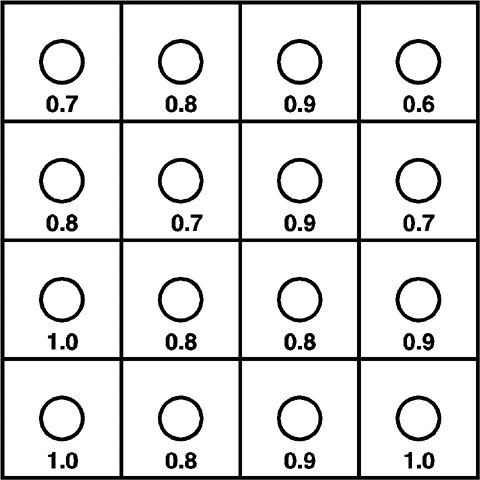Performance of sprinkler and microirrigation systems can be evaluated by measuring operating pressures, application rates, and uniformity of water application under nursery conditions. We discuss the measurement of application rates for overhead sprinkler systems. The application rate is defined as the average depth of water applied per unit time of system operation. For a sprinkler system, application rate is usually expressed in inches per hour.
The measurement of application rates in the nursery will verify the design of the system. It is also important to ensure periodically that application rates of the system have not changed with time. For this reason, the application rate test should be performed at least once a year. Also, it is important to realize that to time the irrigation events, it is necessary to know the depth of water applied in a given (water application rates) unit of time.
Basically, there are three techniques to determine the water application rate of a system:
- The water flow into the irrigation zone can be measured using a flow meter, and the application rate can be calculated based on the area of the zone.
- The application rate can be calculated from the average flow rate of a sprinkler in the zone and the area covered by this sprinkler.
- The application rate can be directly measured with catch cans or rain gauges placed in the irrigated zone.
To use the first method, it is necessary to install a flow meter at the entrance to the irrigation zone. Flow meters are strongly recommended as management tools because it is difficult to manage the system efficiently without knowing how much water is applied during an irrigation event. In addition, flow meters help to detect changes in water application with time or due to malfunctioning of some components. For example, clogged pipe or nozzles will decrease the flow rate, whereas a break in a water delivery line will increase it. However, flow meters are an additional cost, and in many nurseries they are not installed at each irrigation zone.
To use the second method, sprinkler discharge can be determined by directly measuring the volume of water discharged by the sprinkler in a unit of time and dividing it by the area where the water is applied. A flexible hose, which can be slipped over the sprinkler, can be used to direct the water into a container of known volume. For recently installed nozzles, the manufacturer's specification tables can be used after measuring the pressure at the nozzle with a pitot tube. It is important to realize that the discharge may change with time, especially if the water contains abrasive particles such as sand. The nozzle size should be periodically checked for wear using a drill bit with a diameter specified for the nozzle.
In the third method, the application rate is measured directly by placing a grid of catch cans or rain gauges between four sprinklers (for a square or rectangular sprinkler spacing pattern) in the field. It is recommended that a minimum of 16 cans be used in the test. Catch cans should be of the same size and shape, and they should be located in a regular grid clear of obstruction by vegetation. It is good to perform this test before the containers are placed in the zone on a windless day. If the test must be performed with the plants in place, the cans should be elevated above the canopy to avoid interception. A few drops of lightweight oil can be placed in the cans before the test to reduce the evaporation. If the cans have vertical walls, the depth of water in the can will represent the depth of application. However, if the walls are tapered, the depth of application will be the volume of collected water divided by the surface-area of the can opening. The test should be performed in several representative places in the irrigation zone.
Following are three examples representing the methods discussed.
The flow rate into a 1/3-acre zone is 100 gpm as measured by a flow meter. One acre-inch (depth of one inch applied over one acre) is 27,154 gallons. To calculate the application rate:

Calculate the application rate for sprinklers with a discharge of 3 gpm and a square spacing of 20 ft x 20 ft.

Figure 1 presents a layout of 16 cans in the irrigation zone. The depth of water collected in these vertical cans after running the system for one hour is presented below each can. The average application rate in this zone is the average depth collected in the cans and is equal to 0.8 in/hr.
(0.7 + 0.8 + 0.9 + 0.6 + 0.8 + 0.7 + 0.9 + 0.7 + 1.0 + 0.8 + 0.8 + 0.9 + 1.0 + 0.8 + 0.9 + 1.0) / 16 = 0.8 in/hr
